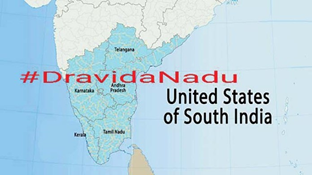

7th July 2022 (7 Topics)
Context
The state of Tamil Nadu is asking for greater autonomy by the Central Government, otherwise, the demand for a ‘separate’ or ‘Dravida Nadu’ could be revived.
About
The demand for Dravida Nadu
- The idea of Dravida Nadu is the old debate on an independent nation comprising the four (now five) South Indian states
- Andhra Pradesh
- Karnataka
- Kerala
- Tamil Nadu
- Telangana

- The Dravida Nadu as a political idea was originally floated by Periyar E.V. Ramasamy who came out with the slogan “Tamil Nadu for Tamils” in 1938 in response to the plan to introduce compulsory learning of Hindi across India.
- By the following year, his clamour had changed to Dravida Nadu because of the South’s cultural oneness.
- Dravidar Kazhagam (DK), a political party was launched, to pursue this goal.
- Though Periyar said the two demands were the same, it never gained traction outside the Tamil areas.
- Political Parties scenario:
- C N Annadurai (1909-1969) was the last Chief Minister of Madras state, and the first Chief Minister of Tamil Nadu.
- He founded the Dravida Munnetra Kazhagam (DMK) after breaking with Periyar.
- DMK ultimately chose to go slow on the demand for an independent Dravida Nadu and instead worked for greater autonomy for Tamil Nadu and better cooperation among the southern states.
|
Recent scenario:
|
- The movement for a separate Dravida country has passed through several stages and meanings.
- The early 20th century agitations against the colonial government of Madras state (of which, along with Tamil Nadu, portions of modern-day Andhra Pradesh, Karnataka, and Kerala were part) often included expressions of regional aspirations.

The Evolution:
- Justice Party (1917):
- The South Indian Liberal Federation, popularly known as Justice Party, which was founded in 1917.
- Sir Pitti Theagaraya Chetty, Dr T M Nair, and Dr C Natesa Mudaliar were the first to raise the flag of anti-Brahminism and oppose the caste system that put Brahmins at the top of the social hierarchy.
- In 1920, the Justice Party won the first legislative council elections held under the Government of India Act, 1919, and formed the government.
- The Congress had boycotted the elections. The Justice Party remained in power until 1926, and then from 1930-37.
- Self-Respect Movement (1925):
- Periyar founded the Self-Respect Movement in 1925.
- He was both anti-caste and anti-religion.
- He advocated major social reforms, including equality for women in society, and supporting birth control for women for their health and well-being.
- He also opposed the domination of Hindi and emphasised the distinct cultural identity of the Tamil nation.
- In 1938, the Justice Party and Self-Respect Movement came together, representing the merger of the party and the movement.
- In 1944, the new outfit was named Dravidar Kazhagam.
- DK was anti-Brahmin, anti-Congress and anti-Aryan (read North Indian).
- It launched a movement for an independent Dravida nation.
- Post-independence, DK continued to demand Dravida Nadu and Periyar refused to contest elections.
- In 1949, Annadurai split from Periyar due to ideological differences and his DMK joined the electoral process.
-
- The DMK’s platforms were social democracy and Tamil cultural nationalism, but Annadurai was silent on Dravida Nadu.
- In 1967, Annadurai became Chief Minister.
- Assertion of Tamil identity
- Since 1967, as power has moved between the DMK and AIADMK, the preservation of Tamil culture and language has been a major focus area of successive state governments.
- The state opposed the three-language formula, which meant Hindi would be taught in schools of South Indian states in 1966 and has continued to protest the introduction of Hindi in education.
- The demand for Dravida Nadu was gradually replaced by a demand for greater autonomy in education and cultural practices.
Linguistic nationalism
- The Linguistic Provinces Commission (or S K Dhar Commission) set up in 1948 argued against a linguistic basis of reorganisation of states, reasoning it could lead to further division.
- In 1952, the freedom fighter Potti Sriramulu died at the end of a 56-day hunger strike undertaken to demand a separate Telugu state.
- In the face of intense public anger, Prime Minister Jawaharlal Nehru announced an intention to create a separate Andhra state.
- In 1953, the States Reorganisation Commission (SRC) was constituted under Justice Fazl Ali, historian K M Panikkar, and parliamentarian H N Kunzru.
- The States Reorganisation Act, 1956, which incorporated some of the suggestions of the SRC, redrew the boundaries of states along linguistic lines, and created the states of Tamil Nadu, Andhra Pradesh, Mysore and Kerala in southern India.
- In the process, a major demand of the linguistic movements was fulfilled, and the idea of an independent Dravida Nadu was weakened.
|
E V Ramasamy ‘Periyar’:
|
More Articles


